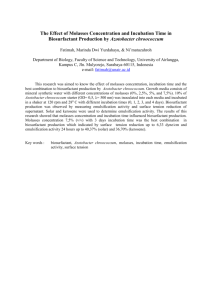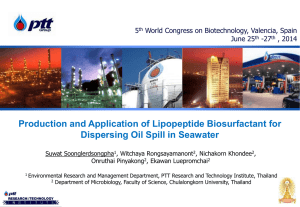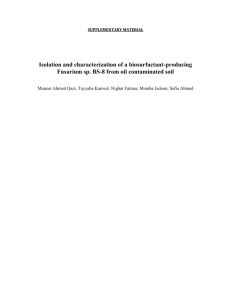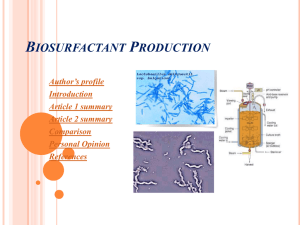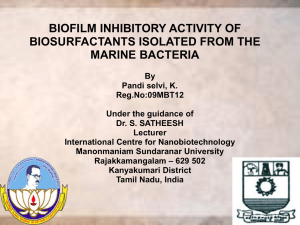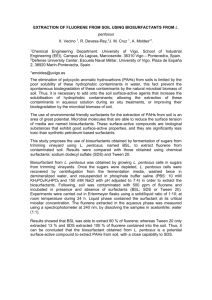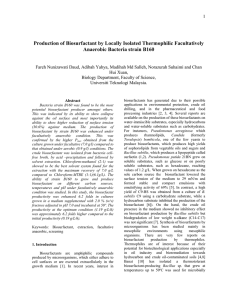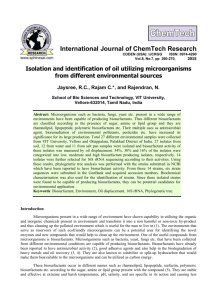Utilization of palm oil mill effluent as a novel and promising
advertisement
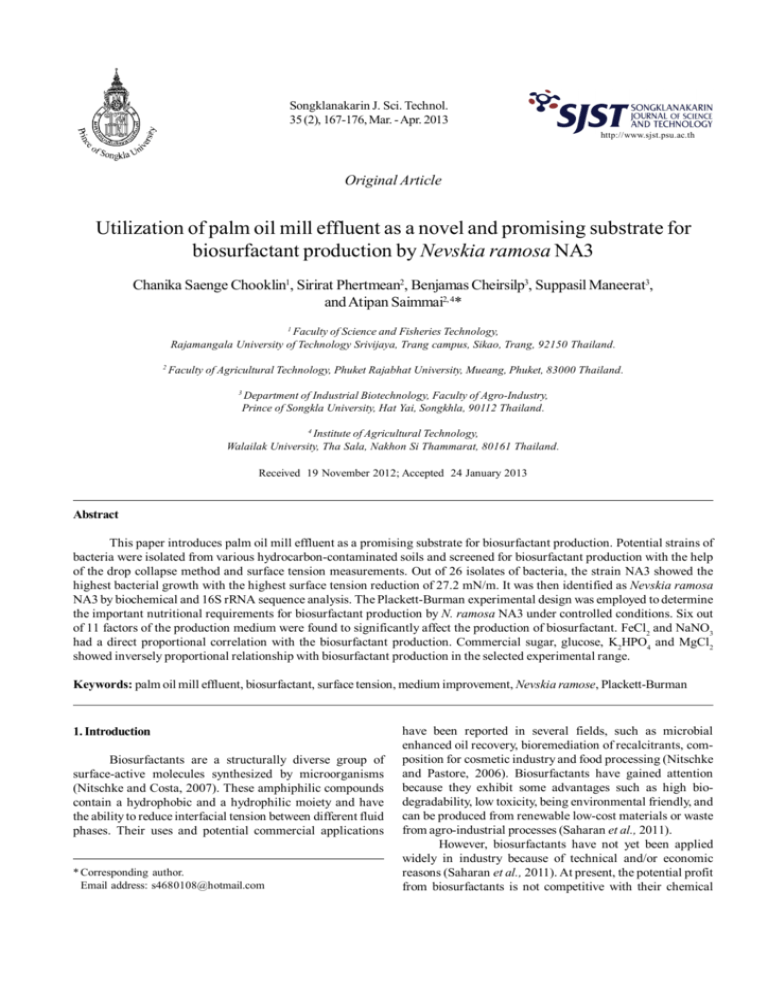
Songklanakarin J. Sci. Technol. 35 (2), 167-176, Mar. - Apr. 2013 http://www.sjst.psu.ac.th Original Article Utilization of palm oil mill effluent as a novel and promising substrate for biosurfactant production by Nevskia ramosa NA3 Chanika Saenge Chooklin1, Sirirat Phertmean2, Benjamas Cheirsilp3, Suppasil Maneerat3, and Atipan Saimmai2, 4* 1 Faculty of Science and Fisheries Technology, Rajamangala University of Technology Srivijaya, Trang campus, Sikao, Trang, 92150 Thailand. 2 Faculty of Agricultural Technology, Phuket Rajabhat University, Mueang, Phuket, 83000 Thailand. 3 Department of Industrial Biotechnology, Faculty of Agro-Industry, Prince of Songkla University, Hat Yai, Songkhla, 90112 Thailand. 4 Institute of Agricultural Technology, Walailak University, Tha Sala, Nakhon Si Thammarat, 80161 Thailand. Received 19 November 2012; Accepted 24 January 2013 Abstract This paper introduces palm oil mill effluent as a promising substrate for biosurfactant production. Potential strains of bacteria were isolated from various hydrocarbon-contaminated soils and screened for biosurfactant production with the help of the drop collapse method and surface tension measurements. Out of 26 isolates of bacteria, the strain NA3 showed the highest bacterial growth with the highest surface tension reduction of 27.2 mN/m. It was then identified as Nevskia ramosa NA3 by biochemical and 16S rRNA sequence analysis. The Plackett-Burman experimental design was employed to determine the important nutritional requirements for biosurfactant production by N. ramosa NA3 under controlled conditions. Six out of 11 factors of the production medium were found to significantly affect the production of biosurfactant. FeCl2 and NaNO3 had a direct proportional correlation with the biosurfactant production. Commercial sugar, glucose, K2HPO4 and MgCl2 showed inversely proportional relationship with biosurfactant production in the selected experimental range. Keywords: palm oil mill effluent, biosurfactant, surface tension, medium improvement, Nevskia ramose, Plackett-Burman 1. Introduction Biosurfactants are a structurally diverse group of surface-active molecules synthesized by microorganisms (Nitschke and Costa, 2007). These amphiphilic compounds contain a hydrophobic and a hydrophilic moiety and have the ability to reduce interfacial tension between different fluid phases. Their uses and potential commercial applications * Corresponding author. Email address: s4680108@hotmail.com have been reported in several fields, such as microbial enhanced oil recovery, bioremediation of recalcitrants, composition for cosmetic industry and food processing (Nitschke and Pastore, 2006). Biosurfactants have gained attention because they exhibit some advantages such as high biodegradability, low toxicity, being environmental friendly, and can be produced from renewable low-cost materials or waste from agro-industrial processes (Saharan et al., 2011). However, biosurfactants have not yet been applied widely in industry because of technical and/or economic reasons (Saharan et al., 2011). At present, the potential profit from biosurfactants is not competitive with their chemical 168 C. S. Chooklin et al. / Songklanakarin J. Sci. Technol. 35 (2), 167-176, 2013 counterparts, due to high costs and low production yields (Makkar and Cameotra, 2002). In order to alleviate these problems, many studies had been carried out using free-cost or low-cost feed stocks or agricultural by-products and wastes as substrates for biosurfactant production (Nitschke and Pastore, 2006; Das and Mukherjee, 2007; Joshi et al., 2008; Sobrinho et al., 2008; Saimmai et al., 2011; 2012a; 2012b; 2012c; 2012d; 2012e; 2012f; 2013). Despite ongoing research using unconventional sources, the selection of appropriate waste substrate is still a challenge (Nawawi et al., 2010). Researchers are facing the problem of finding a waste with the right balance between carbohydrates and lipids to support the optimal growth of microorganisms and maximum production of biosurfactant (Makkar and Cameotra, 1999). Palm oil milling is one of the most important agroindustries in the south of Thailand. The management of the ever-increasing organic waste resulting from palm oil mill discharge has been one of the most worrying environmental issues in the area. This requires a practical and economically viable approach to alleviate the problem (Puetpaiboon and Chotwattanasak, 2004). Waste discharged from palm oil extraction process is known as palm oil mill effluent (POME). It is a colloidal suspension comprising 95-96% water, 0.60.7% oil and 4-5% total solids including 2-4% suspended solids originating in the mixing of sterilizer condensate, separator sludge and hydrocyclone wastewater (Ma, 2000). It can contain about 4,000-6,000 mg/l of oil and grease, which is present either as oil droplets in a water–oil emulsion or floats on the upper layer of the suspension. In this study, POME was introduced as a novel and promising substrate for biosurfactant production. The uses of waste from agroindustry as a substrate for biotechnological production could not only help reducing the costs of production but also pave the way for an effective waste management. Biosurfactants are produced by a wide variety of microorganisms, secreted either extracellulary or localized on the cell surface, predominantly during growth on waterimmiscible substrates (Desai and Banat, 1997). However, each species corresponds to different types of medium components. In this study, POME was used as a new substrate for biosurfactant production. Potential microbes were isolated locally and screened in order to find the best strain that could utilize POME for biosurfactant production. The optimal medium components were determined to maximize the biosurfactant production by the selected strain. 2. Materials and Methods 2.1 Raw material and isolation of microorganisms Raw POME was collected from the receiving tank of Asian Palm Oil Co. Ltd. Krabi, Southern Thailand. Raw POME has a brown color, pH of 4.1-4.5 and a water content of 8792%. The chemical characteristics of the POME are given in Table 1. The POME was kept at -20°C and brought to room temperature before use. Biosurfactant-producing bacteria were isolated from oils or water contaminated with palm oil from a palm oil refinery factory in southern Thailand. The samples were collected in zipper bags and transported to the laboratory for screening and isolation. The method used for screening was using serial dilutions of the samples and plated on minimal salt medium (MSM). MSM agar using POME (20%, v/v) as the carbon source was used for the isolation of bacteria. Morphologically distinct colonies were re-isolated by transfer onto fresh POME-containing agar plates at least three times to obtain pure cultures and subsequently Gram-stained. Pure cultures were stored at -20°C in MSM mixed with sterile glycerol at a final concentration of 30%. 2.2 Preparation of the seed culture A loop full of isolated bacterial colony, previously maintained on NA plate, was transferred to 50 ml nutrient broth (NB, Difco, MI, U.S.A.). The culture was grown on a rotary incubator shaker for 24 hrs at 30°C and 200 rpm. This primary inoculum was grown until the optical density at 600 nm wavelength (OD600) was reached in the 1.80-1.85 absorbance unit (AU) and used to inoculate the production media at 5% (v/v). 2.3 Preparation of production media A minimal salt medium was used as a production medium composed as follow (g/l): K2HPO4, 0.8; KH2PO4, 0.2; CaCl2, 0.05; MgCl2, 0.5; FeCl2, 0.01; (NH4)2SO4, 1.0; and NaCl, 5.0 (Saimmai et al., 2012b) and supplemented with 20% (v/v) of POME. The medium was sterilized by autoclaving at 121°C for 15 min. Fermentation was carried out in 250 ml Erlenmeyer flasks with a 50 ml working volume. For inoculation, the flasks were allowed to cool down to room temperature before transferring 5% (v/v) primary inocula into the production medium. The cultures were incubated in a rotary incubator shaker for 30 hrs at 30°C and 200 rpm. All experiments were carried out in triplicate. Table 1. Chemical characteristics of palm oil mill effluent (POME) used in this study. Parameter Concentration (mg/l) Biochemical oxygen demand (BOD) Chemical oxygen demand (COD) Total carbohydrate Total nitrogen Ammonium-nitrogen Total phosphorus Phosphate Oil Total solids Suspended solids (SS) Ash 23,400 - 52,100 80,100 - 95,000 17,000 - 19,000 850 - 930 24 - 31 96 - 120 15.2 - 20.6 8,500 - 11,000 36,000 - 43,000 9,400 - 12,500 4,200 - 4,600 169 C. S. Chooklin et al. / Songklanakarin J. Sci. Technol. 35 (2), 167-176, 2013 2.4 Screening for potential biosurfactant-producing strains Each isolated strain was subjected to liquid fermentation in the production medium as described above. The ability of each isolate for biosurfactant production was measured qualitatively using the drop collapse method and quantitatively using surface tension measurement and emulsification activity. The strain which showed the lowest surface tension value was selected for further study. The ability of a strain to grow in the presence of POME was also one of the criteria used for strain selection. 2.5 Identification of selected strain The selected strain was identified first by using the biochemical method (Kuda et al., 2011). After observing the cell morphology, Gram staining, catalase testing and the carbohydrate fermentation pattern were examined using the API 50 CHL system and apiweb (bioMerieux, Marcy-l’Etoile, France; http://apiweb.biomerieux. com). In addition, the strain was identified by 16S rRNA gene sequencing and BLAST analysis (DNA Data Bank of Japan (DDBJ), http://www. ncbi.nlm.nih.gov/ BLAST/) were carried out as mentioned in a previous report (Saimmai et al., 2012f). The 16S rRNA gene was amplified with a primer set forward at 27F (AGAGTTTG ATCCTGGCTCAG) and reverse 1492R (GGTTACCTTGTTA CGAC TT). 2.6 Selection of critical medium components: PlackettBurman design The selection of the critical medium components was done after the potential biosurfactant producing strain was determined from a previous experiment. The production medium mentioned earlier was a mixture of POME, and inorganic and organic salts that supported the growth of the selected bacterial strain. Because nutrient requirements vary among the bacterial strains, not all the salts present in the media were necessary for their survival, growth, and bio- surfactant production. In order to determine significant media constituents, experiments were designed in which the medium was kept deficient in one or the other components. A Plackett-Burman design from the statistical software package Design-Expert version 8.0, Trial Program (Stat-Ease, Minneapolis, USA) was used to design and analyze the experiment. The ranges and levels of variables investigated in this study are shown in Table 2. A new carbon source such as glucose and sucrose (commercial sugar) was also introduced as one of the variables during the screening process, in order to evaluate its contribution as compared to glucose. The selected new substrate, POME, was fixed at a concentration of 20% (v/v). Fermentation was carried out for 30 hrs and the surface tension of the culture supernatant was measured using the Du Nuoy ring method. Emulsification activity of the culture supernatant was also evaluated. The Plackett-Burman design is suitable for screening the effect of large numbers of parameters in an experiment and can be used to determine the factors that have significant contributions (Plackett and Burman, 1946). The design assumes that there are no interactions between different media constituents in the range of variables under consideration and a linear approach is considered sufficient for screening (Equation 1): Y = 0 + ixi (i = 1, 2, 3,…, k) (1) where Y is the response, xi is a variable, and i are the regression coefficients. With this experimental design, N factors can be screened with only N+1 experiments thus saving time. The effect of each variable can be calculated by using the standard equation, Equation 2: Effect = 2 [ R(H) - R(L)] / N (2) where R(H) denotes all responses when component was at high levels, R(L) denotes all responses when component was at a low level, and N is the total number of iterations. Table 2. Low and high levels of each variable in Plackett-Burman design. Factor A B C D E F G H I K L Name glucose Commercial sugar Commercial monosodium glutamate NaNO3 (NH4)2SO4 K2HPO4 KH2PO4 CaCl2 NaCl FeCl2 MgCl2 Source Low actual (g/l) High actual (g/l) Carbon Carbon Nitrogen Nitrogen Nitrogen K+ and PO43K+ and PO43Ca2+ + Na and ClFe2+ Mg 2+ 1 1 1 1 1 0.1 0.1 0.1 0.1 0.1 0.1 10 10 5 5 5 1 1 1 1 1 1 170 C. S. Chooklin et al. / Songklanakarin J. Sci. Technol. 35 (2), 167-176, 2013 2.7 Analysis of biosurfactant The analysis was done by first centrifuging the 30 hr– fermentation broth at 9,693 g for 15 min. Residual oil in the culture supernatant was removed by extracting it with an equal volume of hexane in a separatory funnel (Saimmai et al., 2012a). The supernatant was then analyzed by using the drop collapse method, surface tension measurement and emulsification activity. Growth was monitored by measuring the optical density (OD) of the culture broth at 600 nm. Drop collapse test The drop collapse test was performed as described by Youssef et al. (2004). Emulsification activity (E24) was measured as described by Plaza et al. (2006). The assessment of surface tension was done as described by Jachimska et al. (1995). All experiments were carried out in triplicate for the calculation of the mean value. Statistical analysis was performed using Statistical Package for Social Science (SPSS 10.0, for Windows Inc., Chicago, IL). 3. Results and Discussion 3.1 Potential biosurfactant-producing strain Among 221 bacterial isolates obtained from the samples taken from various palm oil contaminated sources in the south of Thailand, including from Krabi Province (NA1, NA2, NA3, KB4, KB5), Satun Province (ST1, ST2, ST3, ST4), Songkhla Province (SK1, SK2, SK3, SK4, SK5, SK6, SK7, SK8), Surat Thani Province (SR1, SR2, SR3, SR4), and from Trang Province (TR1, TR2, TR3, TR4, TR5), only 26 bacterial isolates showed positive results with the drop collapse method. The microbial growth in a production medium is used as a parameter during the primary screening of biosurfactant-producing bacteria. After centrifugation of the fermentation broth, only a few strains showed a significant amount of biomass in the form of pellets which indicated their abilities to grow in the production medium. Their growth on water-immiscible substrate has been associated with the production of biosurfactant. It has been reported that biosurfactant production by growing cells was affected by environmental factors and in most cases the lowest value of surface tension was achieved in the stationary phase (Desai and Banat, 1997; Suwansukho et al., 2008; Priya and Usharani, 2009; Tuleva et al., 2001; Saimmai et al., 2011; 2012b; 2012d; 2012e; 2012f). It was expected that the biosurfactants produced by these isolates might play an essential role for their survival and growth in situations featuring palm oil contamination including POME by facilitating nutrient transport and also enhancing the accessibility of cell-water immiscible substrate. Table 3 shows the Gram staining, growth, emulsification activity and surface activity of selected bacterial isolates. Eighty-five percent of the selected bacterial isolates (22 of 26) were Gram-negative. It has previously been reported that most bacteria isolated from sites with a history of contamination by hydrocarbon oil or its byproducts and other immiscible substrate are Gram-negative due to the presence of outer membranes, which act as biosurfactants (Bodour et al., 2003; Batista et al., 2006; Ruggeri et al., 2009; Saimmai et al., 2012c; 2012g). In addition, this may be a characteristic that contributes to the survival of these populations in such harsh environments (Bicca et al., 1999). Interestingly, these strains did not give high emulsification activity, but they could produce biosurfactants which exhibited high surface tension reduction. It was found that the strain NA3, isolated from a Krabi Province sample, showed the lowest surface tension, suggesting that this strain has high capability in producing low-molecular-weight biosurfactants (Ron and Rosenberg, 2001) by using POME as a substrate. Based on previous data from our group, the excreted high-molecular-weight biosurfactant or bioemulsifier from bacterial isolates can be identified by stabilizing by the hydrocarbon-water emulsion. The major difference between bioemulsifier and low-molecular-weight biosurfactant is the ability to reduce surface tension (Saimmai et al., 2012c; 2012g). Although both of them showed emulsifying activities, the bioemulsifier does not necessarily reduce surface tension. As a result, bacterial isolates that exhibited high emulsifying activity are not always good surface tension reducing strains. In the present results, several isolated strains show a high value of xylene-supernatant emulsion; however, not all of them could effectively reduce the surface tension of the culture medium as compared to the NA3 strain. This would be because the other strains produced bioemulsifiers instead of biosurfactants. As shown in Table 3, the NA3 strain reduced the surface tension of the culture supernatant from 67 to 40 mN/m, resulting in a surface tension reduction of 40%. In addition, the NA3 strain also provided a large diameter from the drop collapse method, indicating the high activity of surface tension reduction by the excreted biosurfactant. Accordingly, the NA3 strain was selected for biosurfactant production using POME as a substrate in the present study. 3.2 Identification of selected bacterial strain Isolated NA3 was identified either through cell and colony morphology or biochemical and physiological characteristics (data not shown). However, due to the intrinsic limitations, the biochemical and physiological test can only provide a preliminarily identification (Huang et al., 2010). The final identification of the strain was accomplished by combining the alignment results of the 16S rRNA sequence analysis with biochemical and physiological characteristics. The result from 16S rRNA analysis was in accord with the colony morphology, cell shape, Gram stain and biochemical tests (data not shown). Their sequences was assigned in the NCBI database and deposited in the DDBJ/EMBL/GenBank under accession number AB569640. The phylogenetic analysis of strain NA3 171 C. S. Chooklin et al. / Songklanakarin J. Sci. Technol. 35 (2), 167-176, 2013 Table 3. Source, Gram’s staining and screening results of isolated strains, DCT: drop collapse test; E24: emulsification activity; ST: surface tension Sources DCT(cm) * E24(%) ST(mN/m) ** Isolate Gram stain OD600 Karbi Province NA1 NA2 NA3 KB4 KB5 Negative Negative Negative Positive Negative 2.5±1.0** 2.8±0.5 3.7±0.2 4.1±0.2 2.9±0.8 1.6±0.2*** 1.9±0.8 4.0±1.0 2.0±0.2 3.0±2.0 31.21±5.20*** 20.50±1.25 48.25±2.27 51.01±0.25 41.26±2.24 61.2±0.2*** 70.5±1.1 40.0±0.8 63.7±2.0 62.5±2.4 Satun Province ST1 ST2 ST3 ST4 Negative Negative Negative Negative 3.5±0.7 1.9±0.4 2.9±0.4 2.8±0.2 1.9±0.1 2.2±0.0 3.0±0.1 2.3±0.1 15.22±3.02 12.3±1.45 8.72±0.54 16.78±2.65 67.2±2.5 54.7±2.0 61.4±1.7 65.0±0.1 Songkhla Province SK1 SK2 SK3 SK4 SK5 SK6 SK7 SK8 Negative Negative Negative Negative Positive Negative Negative Negative 2.7±0.6 3.5±0.2 2.8±0.4 2.6±0.2 1.9±0.5 2.9±0.1 3.0±0.7 2.6±0.2 2.0±0.0 3.2±0.0 3.1±0.0 1.5±0.8 1.7±0.4 2.7±0.4 3.2±0.3 3.5±0.4 26.71±2.56 11.98±2.57 18.78±1.54 24.54±5.65 21.51±2.65 13.28±2.40 24.85±2.89 10.22±3.21 70.4±2.7 63.8±2.1 60.5±2.9 54.2±3.0 62.5±2.0 70.7±2.4 65.6±2.0 66.5±2.8 Surat Thani Province SR1 SR2 SR3 SR4 Negative Negative Negative Negative 2.5±0.4 3.0±0.3 2.7±0.2 2.0±0.25 3.8±0.7 3.7±0.9 3.2±0.6 2.0±0.4 18.91±0.78 36.52±2.32 28.62±2.85 20.25±4.50 68.0±0.7 67.1±2.1 69.7±2.0 65.0±3.8 Trang Province TR1 TR2 TR3 TR4 TR5 Positive Negative Negative Negative Positive 2.1±0.9 3.6±0.7 3.2±0.1 3.3±0.8 2.8±0.4 3.0±0.5 3.2±0.1 3.0±0.0 2.9±0.3 2.1±0.2 33.85±5.98 56.87±3.89 58.20±3.85 46.81±5.89 41.24±2.24 65.0±1.4 66.3±2.0 70.0±2.8 68.2±0.1 65.9±2.0 * Diameter of negative control for DCT was 1.0 mm; Surface tension of MSM supplement with POME was 67.2±0.8 mN/m; *** Values are given as means SD from triplicate determinations. ** using the 16S rRNA gene nucleotide sequences data showed that this strain had the highest homology (over 99.9%) with Nevskia ramosa MAFF 211643 (AB518684). The phylogenetic tree based on neighbor joining analysis of the 16S rRNA gene nucleotide sequences is given in Figure 1. Therefore, the isolate was named as Nevskia ramosa NA3. There have been many reports on the isolation of biosurfactant-producing bacteria in the last few decades (Batista et al., 2006; Ruggeri et al., 2009; Abdel-Mawgoud et al., 2010; Anandaraj and Thivakaran, 2010; Das et al., 2010; Gudina et al., 2010; Janek et al., 2010; Burgos-Diaz et al., 2011; Van Bogaert et al., 2011; Saimmai et al., 2012c; 2012f). However, reports on biosurfactants produced by palm oil contaminated bacteria have been limited to date (Saimmai et al., 2012b; 2012f). It must also be noted that to the best of our knowledge, this is the first report on the capacity of the genus Nevskia to produce a biosurfactant. 3.3 Critical media components Nevskia ramosa NA3 was cultivated in a production medium which was prepared in accord with various concentrations of variables for different experiments as suggested by the Plackett-Burman design. The biosurfactant production by this strain started during the exponential phase and continued up to the stationary phase (Figure 2). The time needed to achieve the maximum concentration of biosurfactant is correlated indirectly with the surface tension reduction. Surface tension was used as the main response due to the fact there was a big difference between iterations. The lowering of the surface tension is directly correlated with higher biosurfactant concentration. Table 4 shows the Plackett-Burman experimental design for 12 iterations at two levels of concentration for each variable along with the response in surface tension (ST) and emulsification activity 172 C. S. Chooklin et al. / Songklanakarin J. Sci. Technol. 35 (2), 167-176, 2013 Figure 1. Phylogenetic tree of the strain NA3 and closest NCBI (BLASTn) strains based on the 16S rRNA gene sequences (neighbor joining tree method). The scale bar indicates 0.01 nucleotide substitutions per nucleotide position. The numbers at node show the bootstrap values obtained with 1000 resampling analyses. The GenBank accession numbers are reported in parenthesis. Figure 2. Time course of growth and biosurfactant production in optimal medium (run 8) by Nevskia ramosa NA3. Table 4. Plackett-Burman experimental design in actual and coded values with corresponding responses. Run 1 2 3 4 5 6 7 8 9 10 11 12 (A) Glucose (g/l) (B) CS (g/l) 10(+1) 10(+1) 1(-1) 10(+1) 10(+1) 10(+1) 1(-1) 1(-1) 1(-1) 10(+1) 1(-1) 1(-1) 1(-1) 10(+1) 10(+1) 1(-1) 10(+1) 10(+1) 10(+1) 1(-1) 1(-1) 1(-1) 10(+1) 1(-1) (C) (D) (E) (F) (G) (H) CMSG NaNO 3 (NH 4)2SO 4 K2HPO 4 KH 2PO 4 CaCl2 (g/l) (g/l) (g/l) (g/l) (g/l) (g/l) 5(+1) 1(-1) 5(+1) 5(+1) 1(-1) 5(+1) 5(+1) 5(+1) 1(-1) 1(-1) 1(-1) 1(-1) 1(-1) 5(+1) 1(-1) 5(+1) 5(+1) 1(-1) 5(+1) 5(+1) 5(+1) 1(-1) 1(-1) 1(-1) 1(-1) 5(-1) 1(-1) 5(+1) 5(+1) 1(-1) 5(+1) 5(+1) 5(+1) 1(-1) 1(-1) 1(-1) 0.1(-1) 0.1(-1) 0.1(-1) 1(+1) 0.1(-1) 1(+1) 1(+1) 0.1(-1) 1(+1) 1(+1) 1(+1) 0.1(-1) 1(+1) 0.1(-1) 0.1(-1) 0.1(-1) 1(+1) 0.1(-1) 1(+1) 1(+1) 0.1(-1) 1(+1) 1(+1) 0.1(-1) 1(+1) 1(+1) 0.1(-1) 0.1(-1) 0.1(-1) 1(+1) 0.1(-1) 1(+1) 1(+1) 0.1(-1) 1(+1) 0.1(-1) (I) NaCl (g/l) (K) FeCl2 (g/l) (L) MgCl2 (g/l) 1(+1) 1(+1) 1(+1) 0.1(-1) 0.1(-1) 0.1(-1) 1(+1) 0.1(-1) 1(+1) 1(+1) 0.1(-1) 0.1(-1) 0.1(-1) 1(+1) 1(+1) 1(+1) 0.1(-1) 0.1(-1) 0.1(-1) 1(+1) 0.1(-1) 1(+1) 1(+1) 0.1(-1) 1(+1) 0.1(-1) 1(+1) 1(+1) 1(+1) 0.1(-1) 0.1(-1) 0.1(-1) 1(+1) 0.1(-1) 1(+1) 0.1(-1) Response E24 (%) ST (mN/m) 48.25±2.15 45.85±7.32 35.27±7.32 42.32±2.95 50.02±0.51 42.85±4.74 57.98±4.23 60.28±2.71 56.27±2.93 38.24±5.17 32.85±2.87 60.02±2.97 40.0±0.6 42.8±0.2 63.5±0.4 51.2±0.3 35.2±1.3 51.2±0.3 32.7±0.4 29.5±1.2 33.8±0.1 58.2±0.3 65.9±0.4 32.0±1.7 173 C. S. Chooklin et al. / Songklanakarin J. Sci. Technol. 35 (2), 167-176, 2013 Table 5. Statistical analysis (ANOVA) for evaluating the significance of variables. Source Model (A) Glucose (B) CS (C) CMSG (D) NaNO3 (E) (NH4)2SO4 (F) K2HPO4 (G) KH2PO4 (H) CaCl2 (I) NaCl (K) FeCl2 (L) MgCl2 Effect SSa dfb -3.17 -7.89 +0.59 +16.42 -1.21 -7.58 +1.69 +1.24 +0.61 +16.21 -7.58 2004.46 48.09 198.57 0.91 751.25 4.97 187.51 9.82 4.25 0.79 608.65 189.65 11 1 1 1 1 1 1 1 1 1 1 1 Mean square F-value 200.45 48.09 198.57 0.91 751.25 4.97 187.51 9.82 4.25 0.79 608.65 189.65 999.51 213.24 987.65 5.01 3326.25 30.85 923.85 48.25 21.25 5.21 3275.25 851.62 p-valuec Significance 0.0214 0.0389 0.0024 0.0985 0.0118 0.0985 0.0187 0.0897 0.1564 0.2841 0.0121 0.0254 Yes Yes Yes No Yes No Yes No No No Yes Yes R2 = 0.9982, predicted R2 = 0.9996; a Sum of squares; b Degree of freedom; c p<0.05 were considered to be significant. (E24). The response was analyzed with the help of the statistical software package Design Expert version 8. Table 5 shows the statistical results obtained after the analysis by Design Expert. Analysis of variance (ANOVA) was performed in order to find the effect and contribution of each variable. Both the Fisher variation ratio (F-value) and p-value from ANOVA were used to confirm the significance of the variables studied. The greater F-value indicated that the variables explained adequately the variation in the data about its mean and the estimated variable effects were realistic. Small p-values were associated with a larger F-value because they imply that the effects were much greater than its standard error. A p<0.05 suggested that the test was statistically significant with a confidence level of above 95%. The contribution percentage is depicted in Figure 3. Six components, NaNO3, FeCl2, commercial sugar (CS), K2HPO4, MgCl2, and glucose, were found to be most significant in contributing to biosurfactant production in this study. The main effect of each variable on biosurfactant production was estimated as the difference between the average of the measurements made at high (+1) and low (-1) levels of the factors. Since our optimum result corresponds to lower response of surface tension, the effect of each term in ANOVA was inverted (that is a positive effect became negative and vice versa). Figure 4 shows the main effect of each variable. A positive effect shows that if a higher concentration was used, a better response was achieved. On the other hand, a negative effect means lower concentrations give better results. 3.4 Significant variables It is clear from Table 5 as well as Figure 3 and 4 that FeCl2 and NaNO3 show the highest level of positive significance in contributing to biosurfactant production by N. Figure 3. Percentage of contribution of each nutrient component for biosurfactant production by Nevskia ramosa NA3. Figure 4. Main effects of the medium constituents in PlackettBurman experimental results for biosurfactant production by Nevskia ramosa NA3 (A: glucose; B: commercial sugar; C: commercial monosodium glutamate; D: NaNO3; E: (NH4)2SO 4; F: K2HPO4; G: KH2PO4; H: CaCl2; I: NaCl; K: FeCl2 and L: MgCl2). 174 C. S. Chooklin et al. / Songklanakarin J. Sci. Technol. 35 (2), 167-176, 2013 ramosa NA3. The contribution of FeCl2 towards the total effects was found to be 25.58% (Figure 3). FeCl2 is a critical component required for the growth and biosurfactant production by Bacillus subtilis ATCC 21332 (Wei et al., 2007) and Rhodococcus sp. (Yao et al., 2009). In addition, it is a source of Fe2+ ions in the medium. The concentration of metal ions plays a very important role in the production of some biosurfactants as they form important cofactors of many enzymes (Saharan et al., 2011). NaNO3 as a source of nitrogen was also found to make a large contribution (25.25%) at a higher concentration. Besides growth, nitrogen plays an important role in structural lipopeptide-biosurfactant as a part of peptide. This justified its significance in the biosurfactant synthesis, particularly for the lipopeptide type (Nawawi et al., 2010). Both CS and glucose as carbon sources showed significant effects in negative terms (Figure 4 and Table 5). Therefore, lower amounts of these carbon sources would lower surface tension and give higher biosurfactant production. This seems counterintuitive at first as most research studies report that glucose was the main contributor during the bacterial metabolism of biosurfactant production (Abouseoud et al., 2008). However, it must be noted that CS and glucose were used only as co-substrates in this study. These co-substrates were used to feed the bacterium only during the initial phase of growth. After the populations matured, a complex carbon source, POME was used as a main substrate in the production medium. The contribution of both co-substrates (CS and glucose) as a co-carbon source was minimal; moreover they showed negative effects. This suggests for later studies the possibility of using CS alone as a co-carbon source compared to more expensive glucose. The concentration level of MgCl2 as a source of Mg2+ ions was found to influence biosurfactant production with 11.85% contribution (Figure 3). This salt was found to possess a negative effect that signifies its effectiveness at a lower concentration in experimental design. Similar studies on evaluating the important nutrient requirement for marine bacterium Bacillus sp. (Mukherjee et al., 2008) and palm oil contaminated soil bacteria S02 (Nawawi et al., 2010) also reported that a lower concentration of Mg2+ influenced biosurfactant production. K2HPO4 also shows a high level of significant effect in negative terms with a percentage contribution of 11.80. This salt is a source of K+ and PO43- and can also act as a buffer in the medium. Although phosphate is essential for bacterial growth, an increase in the concentration of phosphorus in the growth medium was not associated with any remarkable change in growth, emulsifying activity, and surface tension reduction of the culture broth (Pruthi and Cameotra, 2003). 3.5 Non-significant variables KH2PO4, a source of K+ and PO43- was found to be statistically insignificant, contributing only 2.63% to the total effect for biosurfactant production by N. ramosa NA3. This might have been caused by the major involvement of more potassium ions during biosurfactant production. The addition of hydrogen atoms also made the KH2PO4 more acidic compared to K2HPO4, which in turn affected the total broth pH during fermentation. NaCl as a source of Na+ and Cl- ions in the medium showed no significant value (95% confidential level) with only a 0.95% contribution. This was due to the important role of K+ ions in the medium which masks the significance of Na+ ions. CaCl2 as a source of calcium in the mineral salts medium was also found to be insignificant with only a 1.93% contribution. The insignificant nature of CaCl2 was due to the noninvolvement of Ca2+ in any important biochemical reaction and the presence of a more vital Mg2+ ion in the production medium. Commercial monosodium glutamate as a complex organic nitrogen source and (NH4)2SO4 as an inorganic nitrogen source does not show any significant contribution in this study (0.92% and 1.89%, respectively). This suggests the tendency of the selected strain for preferring a small nitrogen concentration for biosurfactant production. 4. Conclusions In this study, POME was introduced as a new substrate for biosurfactant production by using the newly isolated biosurfactant-producing Nevskia ramosa NA3. CS, FeCl2, glucose, K2HPO4, MgCl2, and NaNO3 were identified by the Plackett-Burman design as important parameters for improving biosurfactant production. FeCl2 and NaNO3 showed positive effects, whereas CS, glucose, K2HPO4 and MgCl2 had mainly a negative effect. This suggests that a concentration of FeCl2 and NaNO3 higher than 1.0 and 5.0 g/l, a CS and glucose concentration lower than 1 g/l, K2HPO4 and MgCl2 concentration lower than 1.0 g/l, should be used for further improvement of biosurfactant production by N. ramosa NA3. Acknowledgements We are grateful to Phuket Rajabhat University for providing a scholarship to Saimmai A. This work was supported by the Higher Education Research Promotion and National Research University Project of Thailand, Office of the Higher Education Commission and International Foundation for Science (Sweden) No. F/5204-1. This work also was supported by Walailak University and Rajamangala University of Technology Srivijaya. References Abdel-Mawgoud, A.M., Lepine, F. and Deziel, E. 2010. Rhamnolipids: diversity of structures, microbial origins and roles. Applied Microbiology and Biotechnology. 86, 1323-1336. Abouseoud, M., Maachi, R., Amrane, A., Boudergua, S. and Nabi, A. 2008. Evaluation of different carbon and nitrogen sources in production of biosurfactant by C. S. Chooklin et al. / Songklanakarin J. Sci. Technol. 35 (2), 167-176, 2013 Pseudomonas fluorescens. Desalination. 223, 143-151. Anandaraj, B. and Thivakaran, P. 2010. Isolation and production of biosurfactant producing organism from oil spilled soil. Journal of Bioscience and Bioengineering. 1, 120-126. Batista, S.B., Mounteer, A.H., Amorim, F.R. and Totola, M.R. 2006. Isolation and characterization of biosurfactant/ bioemulsifierproducing bacteria from petroleum contaminated sites. Bioresource Technology. 97, 868-875. Bicca, F.C., Fleck, L.C. and Ayub, M.A.Z. 1999. Production of biosurfactant by hydrocarbon degrading Rhodococcus ruber and Rhodococcus erythropolis. Revista de Microbiologia. 30, 231-236. Bodour, A.A., Drees, K.P. and Maier, R.M. 2003. Distribution of biosurfactant-producing bacteria in undisturbed and contaminated arid southwestern soils. Applied and Environmental Microbiology. 6, 3280-3287. Burgos-Diaz, C., Pons, R., Espuny, M.J., Aranda, F.J., Teruel, J.A., Manresa, A., Ortiz, A. and Marques, A.M. 2011. Isolation and partial characterization of a biosurfactant mixture produced by Sphingobacterium sp. isolated from soil. Journal of Colloid and Interface Science. 361, 195-204. Das, K. and Mukherjee, A.K. 2007. Comparison of lipopeptide biosurfactants production by Bacillus subtilis strains in submerged and solid state fermentation systems using a cheap carbon source: some industrial applications of biosurfactants. Process Biochemistry. 42, 1191-1199. Das, P., Mukherjee, S., Sivapathasekaran, S. and Sen, R. 2010. Microbial surfactants of marine origin: potentials and prospects. Advances in Experimental Medicine and Biology. 672, 88-101. Desai, J.D. and Banat, I.M. 1997. Microbial production of surfactants and their commercial potential. Microbiology and Molecular Biology Reviews. 61, 47-64. Gudina, E.J., Rocha, V., Teixeira, J.A. and Rodrigues, L.R. 2010. Antimicrobial and antiadhesive properties of a biosurfactant isolated from Lactobacillus paracasei ssp. paracasei A20. Letters in Applied Microbiology. 50, 419-424. Huang, X.F., Guan, W., Liu, J., Lu, L.J., Xu, J.C. and Zhou, Q. 2010. Characterization and phylogenetic analysis of biodemulsifier-producing bacteria. Bioresource Technology. 101, 317-323. Jachimska, B., Lunkenheimer, K. and Malysa, K. 1995. Effect of position of the functional group on the equilibrium and surface properties of butyl alcohols. Journal of Colloid and Interface Science. 176, 31-38. Janek, T., Lukaszewicz, M., Rezanka, T. and Krasowska, A. 2010. Isolation and characterization of two new lipopeptide biosurfactants produced by Pseudomonas fluorescens BD5 isolated from water from the arctic archipelago of Svalbard. Bioresource Technology. 101, 6118-6123. 175 Joshi, S., Bharucha, C., Jha, S., Yadav, S., Nerurkar, A. and Desai, A.J. 2008. Biosurfactant production using molasses and whey under thermophilic conditions. Bioresource Technology. 99, 195-199. Kuda, T., Kyoi, D., Takahashi, H., Obama, K. and Kimura, B. 2011. Detection and isolation of p-nitrophenol-lowering bacteria from intestine of marine fishes caught in Japanese waters. Marine Pollution Bulletin. 62, 16221627. Ma, A.N. 2000. Environmental management for the palm oil industry. Palm Oil Development. 30, 1-9. Makkar, R. and Cameotra, S. 2002. An update on the use of unconventional substrates for biosurfactant production and their new applications. Applied Microbiology and Biotechnology. 58, 428-434. Makkar, R.S. and Cameotra, S.S. 1999. Biosurfactant production by microorganisms on unconventional carbon sources - a review. Journal of Surfactants and Detergents. 2, 237-241. Mukherjee, S., Das, P., Sivapathasekaran, C. and Sen, R. 2008. Enhanced production of biosurfactant by a marinebacterium on statistical screening of nutritional parameters. Biochemical Engineering Journal. 42, 254260. Nawawi, W.M.F.W., Jamal, P. and Alam, M.Z. 2010. Utilization of sludge palm oil as a novel substrate for biosurfactant production. Bioresource Technology. 101, 92419247. Nitschke, M. and Costa, S.G. 2007. Biosurfactants in food industry. Trends in Food Science and Technology. 18, 252-259. Nitschke, M. and Pastore, G. 2006. Production and properties of a surfactant obtained from Bacillus subtilis grown on cassava wastewater. Bioresource Technology. 97, 336-341. Plackett, R.L. and Burman, J.P. 1946. The design of optimum multifactorial experiments. Biometrika. 33, 305-325. Plaza, G.A., Zjawiony, I. and Banat, I.M. 2006. Use of different methods for detection of thermophilic biosurfactantproducing bacteria from hydrocarbon contaminated and bioremediated soils. Journal of Petroleum Science and Engineering. 50, 71-77. Priya, T. and Usharani, G. 2009. Comparative study for biosurfactant production by using Bacillus subtilis and Pseudomonas aeruginosa. Botany Research International. 2, 284-287. Pruthi, V. and Cameotra, S.S. 2003. Effect of nutrients on optimal production of biosurfactants by Pseudomonas putida-a Gujarat oil field isolate. Journal of Surfactants and Detergents. 6, 65-68. Puetpaiboon, U. and Chotwattanasak, J. 2004. Anaerobic treatment of palm oil mill wastewater under mesophilic condition. Proceeding of the 10th World Congress on Anaerobic Digestion 2004, Montreal, Canada, August 29-September 2, 2004. 176 C. S. Chooklin et al. / Songklanakarin J. Sci. Technol. 35 (2), 167-176, 2013 Ron, E.Z. and Rosenberg, E. 2001. Natural roles of biosurfactants. Environmental Microbiology. 3, 229-236. Ruggeri, C., Franzetti, A., Bestetti, G., Caredda, P., La Colla, P., Pintus, M., Sergi, S. and Tamburini, E. 2009. Isolation and characterization of surface active compoundproducing bacteria from hydrocarbon-contaminated environments. International Biodeterioration and Biodegradation. 63, 936-942. Saharan, B.S., Sahu, R.K. and Sharma, D. 2011. A review on biosurfactants: fermentation, current developments and perspectives. Genetic Engineering and Biotechnology Journal. GEBJ-29. Saimmai, A., Kaewrueng, J. and Maneerat, S. 2012a. Used lubricating oil degradation and biosurfactant production by SC-9 consortia obtained from oil contaminated soil. Annals of Microbiology. 62, 1757-1767. Saimmai, A., Rukadee, O., Onlamool, T., Sobhon, V. and Maneerat, S. 2013. An efficient biosurfactant-producing bacterium Selenomonas ruminantium CT2, isolated from mangrove sediment in south of Thailand. World Journal of Microbiology and Biotechnology. 29, 87-102. Saimmai, A., Rukadee, O., Onlamool, T., Sobhon, V. and Maneerat, S. 2012b. Characterization and phylogenetic analysis of microbial surface active compoundsproducing bacteria. Applied Biochemistry and Biotechnology. 168, 1003-1018. Saimmai, A., Rukadee, O., Onlamool, T., Sobhon, V. and Maneerat, S. 2012c. Isolation and functional characterization of a biosurfactant produced by a new and promising strain of Oleomonas sagaranensis AT18. World Journal of Microbiology and Biotechnology. 28, 2973-2986. Saimmai, A., Sobhon, V. and Maneerat, S. 2011. Molasses a whole medium for bosurfactants production by Bacillus strains and their application. Applied Biochemistry and Biotechnology. 165, 315-335. Saimmai, A., Sobhon, V. and Maneerat, S. 2012d. Production of biosurfactant from a new and promising strain of Leucobacter komagatae 183. Annals of Microbiology. 62, 391-402. Saimmai, A., Sobhon, V., Rukadee, O. and Maneerat, S. 2012e. Comparison of biosurfactants produced by Bacillus subtilis TD4 and Pseudomonas aeruginosa SU7 for microbial surfactant-enhanced oil recovery. Journal of Scientific and Industrial Research. 71, 396-406. Saimmai, A., Tani, A., Sobhon, V. and Maneerat, S. 2012f. Mangrove sediment, a new source of potential biosurfactant producing bacteria. Annals of Microbiology. 62, 1669-1679. Sobrinho, H.B.S., Rufino, R.D., Luna, J.M., Salgueiro, A.A., Campos-Takaki, G.M., Leite, L.F.C. and Sarubbo, L.A. 2008. Utilization of two agroindustrial by-products for the production of a surfactant by Candida sphaerica UCP0995. Process Biochemistry. 43, 912-917. Suwansukho, P., Rukachisirikul, V., Kawai, F. and Kittikun, A.H. 2008. Production and applications of biosurfactant from Bacillus subtilis MUV4. Songklanakarin Journal of Science and Technology. 30, 87-93. Tuleva, B.K., Ivanov, R.G. and Christova, N.E. 2001. Biosurfactant production by a new Pseudomonas putida strain. Zeitschrift für Naturforschung, Section C-A, Journal of Biosciences. 57, 356-360. Van Bogaert, I.N.A., Zhang, J. and Soetaert, W. 2011. Microbial synthesis of sophorolipids. Process Biochemistry. 46, 821-833. Wei, Y.H., Lai, C.C. and Chang, J.S. 2007. Using Taguchi experimental design methods to optimize trace element composition for enhanced surfactin production by Bacillus subtilis ATCC 21332. Process Biochemistry. 42, 40-45. Yao, Y., Lv, Z., Min, H., Lv, Z. and Jiao, H. 2009. Isolation, identification and characterization of a novel Rhodococcus sp. strain in biodegradation of tetrahydrofuran and its medium optimization using sequential statistics-based experimental designs. Bioresource Technology. 100, 2762-2769. Youssef, N.H., Dunacn, K.E., Nagle, D.P., Savage, K.N., Knapp, R.M. and McInerney, M.J. 2004. Comparison of methods to detect biosurfactant production by diverse microorganism. Journal of Microbiological Methods. 56, 339-347.
